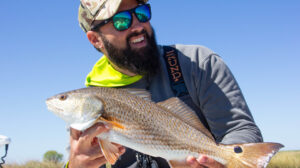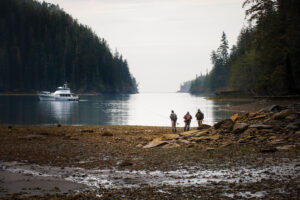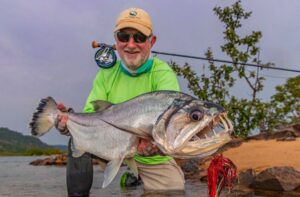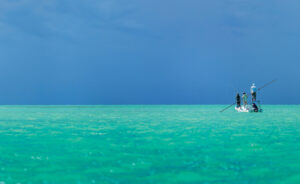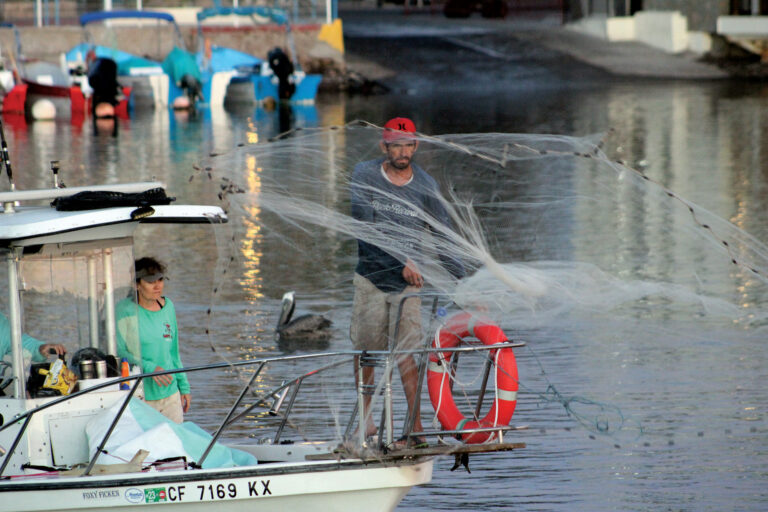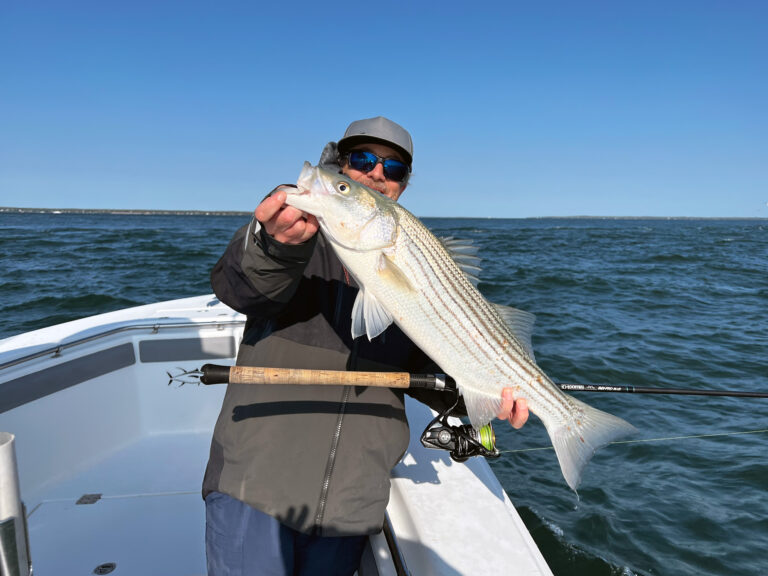 Kendall Osborne has 16 years of experience chasing tarpon in the waters behind Virginia’s barrier islands.
Kendall Osborne has 16 years of experience chasing tarpon in the waters behind Virginia’s barrier islands. Corn and soybean fields are the last scenery that blows past my SUV as I turn left onto a country road in the heart of Virginia’s Eastern Shore. It’s late August, and humidity hangs in the air as a dragonfly goes kersplat! against my windshield. A tractor rumbles by as I pull over to figure out how I’ve become so lost.
It’s not the backdrop typically associated with tarpon fishing, but that’s what I am here to do.
 Osborne is often alone on the tarpon grounds, except for a few locals.
Osborne is often alone on the tarpon grounds, except for a few locals. I sort my bearings and make my way to a remote launch ramp where longtime friend and tarpon devotee Kendall Osborne is rigged and ready with his Dragonfly Emerger, a 16-foot flats skiff that’s perfect for the skinny waters where we’ll hunt for silver kings among marsh-lined bays, guts and creeks.
Osborne has spent the last 16 years deciphering these Virginia waters while learning how to find the tarpon that summer here between July and September. I’ve promised to remain vague about locations and obscure any photos that could potentially reveal his fishing spots. While the fact that tarpon swim here each summer is not a secret, I understand why Osborne has asked me to be discreet: He’s put in a lot of time dialing in this fishery.
 Flies live a pretty short life once they come in contact with a tarpon.
Flies live a pretty short life once they come in contact with a tarpon.We launch the boat and motor past an aquaculture operation as Osborne fills me in about his tarpon experiences. “I first came here in 2005 after I heard about people catching tarpon on fly,” he recalls. “I had a 13-foot Boston Whaler back then. I caught my first tarpon with a fly in 2008. Based on what I know, I think I am the fifth person to catch one on fly in Virginia. Others took the first four going back to 2003, among them Bill Shepherd, Charles Stant, Bob Hutchinson and Art Greason, who caught his tarpon on fly with me.”
A few miles into the marsh, Osborne pushes the skiff into a turn, and an expanse of water opens in front of us. The bay is as flat as glass, reflecting the hazy, pastel-blue sky above and giving it the appearance of a Bahamas bonefish flat. “This is completely different when the tide’s gone out,” Osborne says. “There are oyster bars, mud banks and other things to run your boat into and onto. I know — I’ve hit almost all of them. You should see the bottom of my boat. I also trashed an outboard clogging the cooling passages with sediment from running aground.”
Osborne shuts down the outboard. There are no other boats around. Egrets and herons hunt the marshy shallows. The skiff glides to a stop, and the landscape instantly strikes me as one of the most still, beautiful places I’ve ever fished. Not a breath of breeze, a ripple of water or a note of birdsong. Moments later, a deep boom breaks the silence. “That’s a fighter jet out of Langley,” Osborne says, referring to Joint Base Langley-Eustis. “They have a training area out in the ocean.”
 When the bite turns on, the 60- to 70-pound tarpon are a formidable foe.
When the bite turns on, the 60- to 70-pound tarpon are a formidable foe. Osborne deploys the trolling motor and hands me an 11-weight tipped with a root-beer-colored streamer fly. He tells me that fishing with bait (live or dead) is far more productive, but I’m here to tempt a tarpon with a fly. I stand watch on the bow, looking for signs of rolling fish. “Not seeing much up here,” I say. Osborne tells me to keep looking. Moments later I spot what must be a 6-foot tarpon just below the surface about 10 feet ahead of me. The fish sees the boat, then opens a car-sized hole in the water with a swat of its tail. “Holy shit, they’re here!”
The bay suddenly comes alive. Dorsal fins, silvery-green backs and tails break the surface as far as the eye can see. Schools of terrorized bait rain upward while smaller tarpon gulp the scorched August air. About 100 yards to starboard, another behemoth explodes, sending a handful of mullet airborne. “Is this normal?” I ask Osborne.
“This is pretty exceptional,” he responds. “Let’s find some we can cast to.” He cuts the trolling motor and poles the skiff. I have a knot of anxious excitement in my stomach as sweat soaks my body. Biting flies leave bloody welts on my legs. I’m smothered in sunscreen, but I still feel the sun crisping my skin like an oven-roasted chicken. The conditions are about as miserable as I’ve ever fished in.
“This is perfect tarpon weather,” Osborne pipes in. “The worst conditions for humanoids are the best conditions for tarpon. They love this kind of weather.”
 Tarpon love the hot and humid weather that humans hide from.
Tarpon love the hot and humid weather that humans hide from.A pair of 60- to 70-pound tarpon roll across our bow about 50 feet away. “You see ’em?” Osborne asks.
“Yup, I’ve got them,” I respond, setting up a cast ahead of the two fish. My fly lands perfectly ahead of the fish. I slowly retrieve. The tarpon swim up to the suspended fly, give it a look, then reject it and swim away. My heart is pounding.
“Don’t worry, we’ll get another shot,” Osborne says. “This is the most exciting fishing there is, even if you don’t catch one. Having one eat and jump and get off is more exciting than catching most other fish.”
We continue to see rolling tarpon and eventually come across a smaller fish off our port bow. I line up another cast, wriggle the fly and watch the fish ignore my offering. I blurt out a string of expletives. Compounding my frustration is the eelgrass blades that endlessly conspire to foul my “weedless” fly.
“There are hundreds of acres of grass beds here,” Osborne says. “The Nature Conservancy planted loads of it years ago, and it’s just continued to spread. It’s great habitat for the fish, but it makes fly-fishing a pain in the ass.”
I happen to know one of the people responsible for planting this eel grass. Barry Truitt is a retired conservation scientist who worked for The Nature Conservancy. He’s also a Virginia tarpon sharpie who started fishing off the Eastern Shore in 1974 and still holds the state record for tarpon, a 130-pounder caught in 1975 soaking bait.
“When I started fishing down here, all I ever heard was that the first tarpon in Virginia was caught in 1955 by Claude Rogers, who took two of them while fishing for red drum at night,” Truitt says. “But a Peninsula Enterprise newspaper article in August 1936 mentions a Virginia tarpon that was caught by chance near Chincoteague [Virginia]. So they’ve probably been coming here forever.”
 According to researchers, these tarpon most likely migrate north from the Florida Keys and hang out from June through October before they turn around and head back south.
According to researchers, these tarpon most likely migrate north from the Florida Keys and hang out from June through October before they turn around and head back south. Truitt says that well-to-dos from Richmond, Virginia, tried to establish a tarpon fishery off the Eastern Shore, but the challenges shattered their hopes. “You’ve been out there; you know how awful the conditions are,” Truitt says. “And it’s not like you can just go out there and start catching them. It takes years to learn the water, and then you have to find the fish.” He says most folks hear about the tarpon, put their boat up on a mud bank or oyster bar, never see any fish, broil in the sun, get eaten by flies and never come back.
Osborne puts me in front of several tarpon, but none is willing to take a fly. “Am I doing something wrong?” I ask.
“Nothing that would explain why all these fish have lockjaw,” he says. “We’d have at least jumped a couple by now on a normal day.” He says getting a hook into the jaw of one of these beasts and bringing it alongside is rare, but he’s caught a decent number through the years. “I’m very careful if I hook one well. I pour on the drag and fight the fish quickly. I never take a fish out of the water. They’re too important to me to risk harming one.”
At about half-past noon, a looming summer storm drives us off the water. Osborne expertly pilots the skiff through a narrow, winding cut in the marsh and back to the ramp, where two other skiffs are loading out. The men talk to Osborne as I begin packing for the three-and-a-half-hour drive home.
“You see other tarpon anglers around here much?” I ask Osborne after the anglers leave. “No, but there’s definitely more pressure on the fish these days,” he says. “There are a couple of guys running trips, but it’s not like tons of people come here to fish for tarpon. You have to be a little bit crazy to enjoy this.”
About a week after our trip, I contacted Lucas P. Griffin, a postdoctoral research associate at the University of Massachusetts-Amherst, who works with the Bonefish and Tarpon Trust. He leads the organization’s Tarpon Acoustic Tagging Project, which aims to identify the movements of the fish and conservation concerns. He’s tuned into the fish that migrate to Virginia.
“We don’t have enough acoustic tags swimming around to identify hyper-specific groups of fish migrating to Virginia, but our receivers do indicate a population of fish in those waters starting in June that stay all the way through October,” Griffin says. “These are mostly fish from the [Florida] Keys that migrate north after the spring run, summer in Virginia and then return south in fall. For them to stay mostly in one location for such a long time likely indicates that there is a rich food source in the coastal and ocean waters off Virginia. It’s definitely a population subset we keep an eye on.”
Griffin says that while tarpon can be found farther north — a New Jersey man speared one in Barnegat Inlet days before we spoke — the population that exists in Virginia is consistent every year, not just a chance occurrence.
Reconnecting with Osborne, he says tarpon have been scarce since we fished together. “I put 40 miles behind me today and didn’t see one fish, even where we were last week,” he says. A week later, he texts: “I went twice this week and only saw two. You and I may have already seen the best fishing of the year.”
It reminded me of a Bob “Hutch” Hutchinson quote that Osborne relayed to me. Hutchinson, who was the outdoors editor for The Virginian-Pilot newspaper and an excellent tarpon angler, was often asked where to find and catch tarpon in Virginia. His response was simple: “Everywhere and nowhere.”
Sounds pretty accurate to me.


